Krohne BM 26 A User Manual
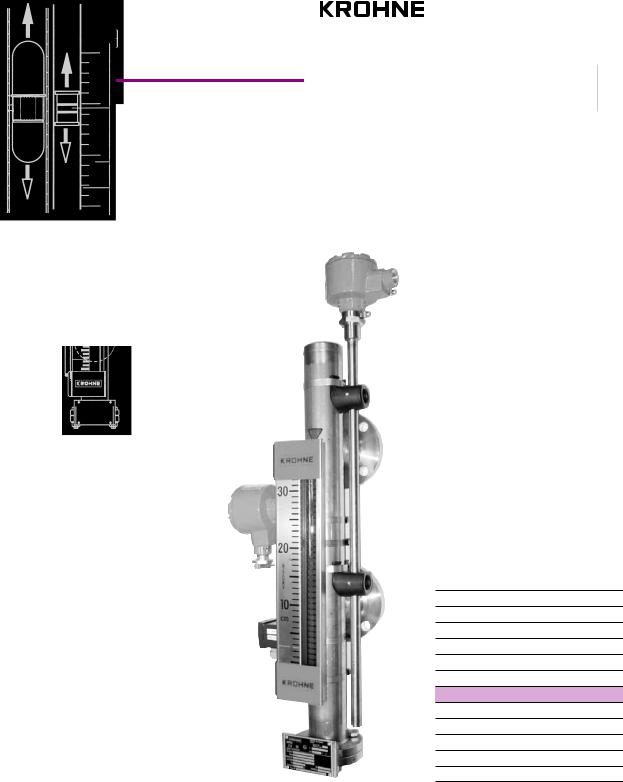
© KROHNE 10/2006 |
7.02186.26.00 |
|
|
|
|
|
|
|
|
|
|
|
|
|
|
||
|
|
|
|
|
|
|
||
|
|
|
|
|
|
|
|
|
 CMD
CMD
Installation and operating instructions
Bypass Level Indicator
BM 26 A
For level or interface measurement of liquids
Variable area flowmeters
Vortex flowmeters
Flow controllers
Electromagnetic flowmeters
Ultrasonic flowmeters
Mass flowmeters
Level measuring instruments
Communications engineering
Engineering systems & solutions
Switches, counters, displays and recorders
Heat metering
Pressure and temperature
Subject to change without notice.
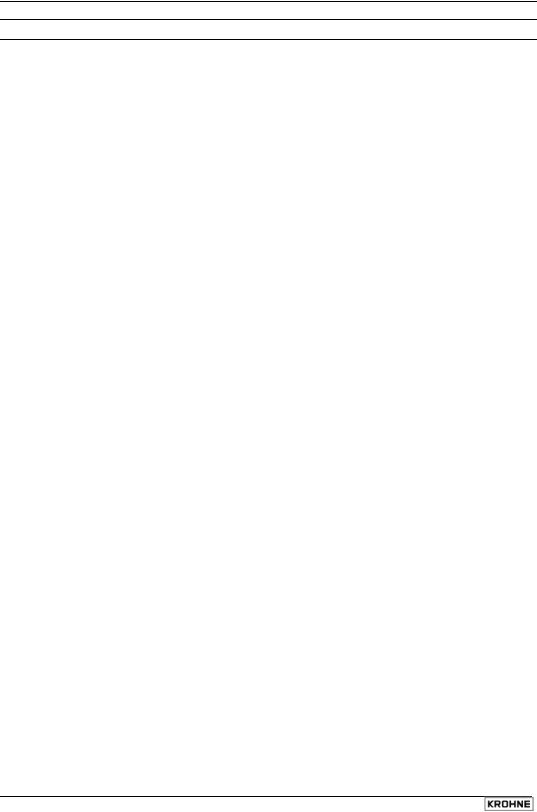
Contents |
|
|
General advice on safety............................................................................................................. |
4 |
|
Description: BM 26 A bypass level indicator with magnetic flaps or bar scale ..................... |
4 |
|
Documentation symbols ............................................................................................................. |
5 |
|
Handling ....................................................................................................................................... |
5 |
|
Product liability and warranty..................................................................................................... |
5 |
|
Items supplied.............................................................................................................................. |
5 |
|
Standards / Approvals................................................................................................................. |
6 |
|
Official approvals and certificates ............................................................................................. |
7 |
|
Principal gauge components...................................................................................................... |
7 |
|
1 |
Installation ......................................................................................................................... |
8 |
1.1 |
Packing and storage ............................................................................................................. |
8 |
1.2 |
BM 26 A construction details............................................................................................... |
10 |
1.3 |
Mechanical installation requirements .................................................................................. |
12 |
1.4 |
Mounting on the tank........................................................................................................... |
13 |
1.5 |
Start-up procedure .............................................................................................................. |
14 |
1.6 |
True level indication ............................................................................................................ |
15 |
1.6.1 Level measurement using the local indicator and scale .................................................. |
15 |
|
1.6.2 Floats ..................................................................................................................... |
16 |
|
1.6.3 Changing the process conditions .................................................................................... |
18 |
|
1.6.4 Correcting the scale position to accurately read true liquid level..................................... |
20 |
|
1.6.5 Functional check of local level display (bar indicator only).............................................. |
22 |
|
2 |
Level transducer ............................................................................................................. |
23 |
2.1 |
General notes...................................................................................................................... |
23 |
2.2 |
Transmitters ........................................................................................................................ |
24 |
2.2.1 Transmitter versions for the BM 26 A.............................................................................. |
24 |
|
2.2.2 Electrical connections ..................................................................................................... |
24 |
|
3 |
Limit switches / contacts................................................................................................ |
26 |
3.1 |
General notes...................................................................................................................... |
26 |
3.2 |
Designation code for defining limit switch versions ............................................................. |
26 |
3.3 |
Limit switch options for the BM 26 A (non-Ex)..................................................................... |
26 |
3.4 |
Limit switch options for the BM 26 A (ATEX version) .......................................................... |
27 |
3.5 |
How to use a limit switch..................................................................................................... |
27 |
3.5.1 Operating principle .......................................................................................................... |
27 |
|
3.5.2 Installation ..................................................................................................................... |
27 |
|
3.5.3 Overall dimensions of limit switches mounted on measuring tube .................................. |
29 |
|
3.5.4 Limit switch dimensions (without bracket and clamp)...................................................... |
30 |
|
3.5.5 Electrical connections ..................................................................................................... |
31 |
|
3.6 |
Fine adjustments to the limit switch trigger point................................................................. |
33 |
3.6.1 General notes.................................................................................................................. |
33 |
|
3.6.2 Fine adjustments to the limit switch trigger point............................................................. |
33 |
|
3.6.3 Switching point diagram and offset values for limit switches........................................... |
34 |
|
2 |
Installation and Operating Instructions BM 26 A |
|

4 |
Special versions.............................................................................................................. |
35 |
4.1 |
Low-temperature versions AG-TR-IC/TR............................................................................ |
35 |
4.2 |
High-temperature versions HR-IC/HR................................................................................. |
35 |
4.3 |
Heating system for measuring tube BM 26 A/B .................................................................. |
36 |
4.4 |
Liquid/liquid interface measurement BM 26 A/TS ............................................................... |
36 |
5 |
Maintenance .................................................................................................................... |
37 |
6 |
Ordering spare parts ...................................................................................................... |
37 |
7 |
Technical data................................................................................................................. |
38 |
7.1 |
Technical data: BM 26 A..................................................................................................... |
38 |
7.2 |
Technical data: level transmitter modules........................................................................... |
40 |
7.3 |
Technical data: limit switches.............................................................................................. |
41 |
7.4 |
Guide tube assembly materials........................................................................................... |
42 |
7.4.1 Maximum operating conditions for BM 26 A with 316 Ti steel measuring tube ............... |
42 |
|
7.4.2 Flange categories for operating conditions in a 316Ti steel measuring tube .................. |
42 |
|
7.4.3 Maximum operating conditions for BM 26 A with 316 L steel measuring tube ................ |
43 |
|
7.4.4 Flange categories for operating conditions in a 316L steel measuring tube ................... |
43 |
|
7.5 |
BM 26 A weights and dimensions ....................................................................................... |
44 |
7.5.1 Weights ..................................................................................................................... |
44 |
|
7.5.2 Indicator dimensions ....................................................................................................... |
44 |
|
7.5.3 Overall dimensions of measuring tube classes (with loose or welding neck flanges) ..... |
44 |
|
7.5.4 Distance of welding neck flange raised facing from measuring tube axis ....................... |
47 |
|
8 |
Measuring principle........................................................................................................ |
48 |
Appendices ................................................................................................................................ |
49 |
|
Appendix A: Declaration of conformity: CE ............................................................................ |
49 |
|
Appendix B: Declaration of conformity: Pressure Equipment Directive 97/23/EC .............. |
50 |
|
Appendix C: EC-Type Examination Certificate INERIS 02ATEX0088X ................................. |
51 |
|
If you need to return level gauges for testing or repair to KROHNE..................................... |
71 |
|
Installation and Operating Instructions BM 26 A |
3 |

General advice on safety
This manual gives a complete set of instructions for the installation, operation and maintenance of the ATEX version of the BM 26 A Bypass Level Indicator.
This instrument is designed to function at near constant pressure conditions. The instrument must be installed and used by suitably qualified personnel.
Our conformity declaration is limited to the parts of the level indicator that are under pressure, excluding parts that may be dismantled (e.g. valves).
Events that are not taken into account in the calculations include: exceptional risks such as earthquakes, bad weather, acts of destruction (such as sabotage, terrorism, vandalism, etc.) and fire.
WARNING
Special regulations are applicable to the use of equipment in hazardous locations, and these are described in this booklet. Data is supplied on explosion protection.
Special measures must be taken when using titanium floats in order to avoid friction between the titanium and stainless steel causing sparks in an inflammable gaseous environment.
The standard design calculation does not take into account the theoretical coefficient of corrosion. The product circulating in the vessel must not have properties that give rise to surface erosion.
Description: BM 26 A bypass level indicator with magnetic flaps or bar scale
The BM 26 A bypass level indicator is used for measuring level, interface or volume in open or pressurized tanks. It is mounted adjacent to the tank and uses the principle of communicating vessels – the liquid level in the measuring tube corresponds to the liquid level in the tank. Due to its design, the unit is suitable for use in connection with corrosive, toxic or flammable substances and in severe service conditions.
The local indicator consists of:-
•A bar indicator (follower magnet) in a Pyrex glass tube as standard
•or a flap indicator (yellow/black magnetic flaps) in a Pyrex glass tube. No power is required for local liquid-level indication.
Optionally, the unit can be equipped or retrofitted with an electrical analogue level transducer system and/or limit switches.
Use in hazardous areas
The BM 26 A bypass level indicator is approved for use in explosive atmospheres when equipped with the appropriate options. It is imperative that the approval certificate details and boundary conditions are observed.
4 |
Installation and Operating Instructions BM 26 A |
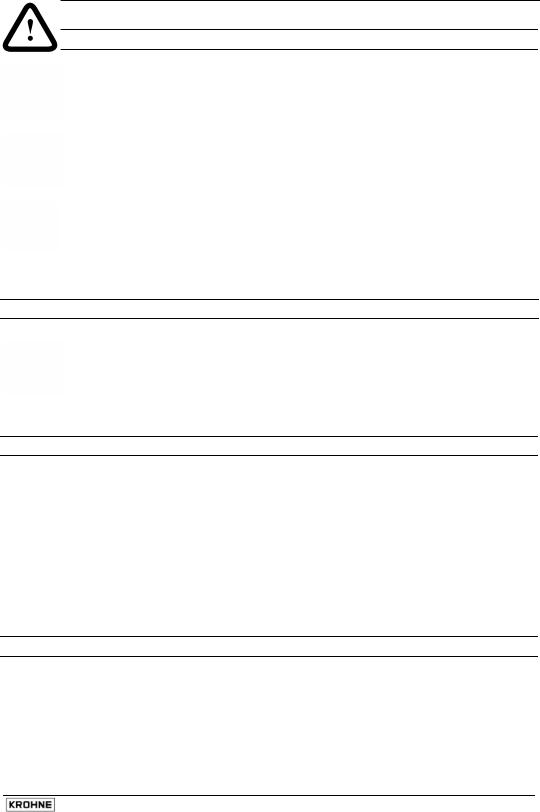
Documentation symbols
CAUTION
Information that, if not followed, may lead to actions resulting in incorrect functioning of the device.
WARNING
Information that, if not followed, may lead to actions resulting in measurement error, personal injury and/or damage to the device.
Information and instructions for Ex applications
Information that must be used to observe the safety requirements for installation, operation and maintenance in hazardous areas. If instructions are not followed, this may result in personal injury, damage to the device and/or incorrect functioning of the device.
Handling
WARNING
The device normally weighs from 14.5 kg or 32 lb to 40kg or 88 lb. Carry the device using at least two people, lifting it by the process connections. Lifting gear may also be used but no attempt should be made to lift the device by the measuring scale, level transducer or other attached equipment.
Product liability and warranty
The BM 26 A bypass level indicator is designed exclusively for liquid-level, liquid/liquid interface or volume measurement, depending on the scale and float selected by the customer.
Special codes and regulations apply to its use in hazardous areas.
Responsibility as to suitability and intended use of this bypass level indicator rests solely with the operator.
Improper installation and operation of these bypass level indicators may lead to loss of warranty. In addition, the “General conditions of sale” forming the basis of the purchase contract are applicable.
If the bypass level indicator needs to be returned to KROHNE, please read and follow the instructions given at the end of this manual.
Items supplied
•BM 26 A bypass level indicator option: with or without current output or limit switches
•These installation and operating instructions
•Approval documents / certificates of conformity (for hazardous duty only)
Supplied without mounting accessories (stud bolts, flange gaskets and wiring to be provided by customer).
Installation and Operating Instructions BM 26 A |
5 |
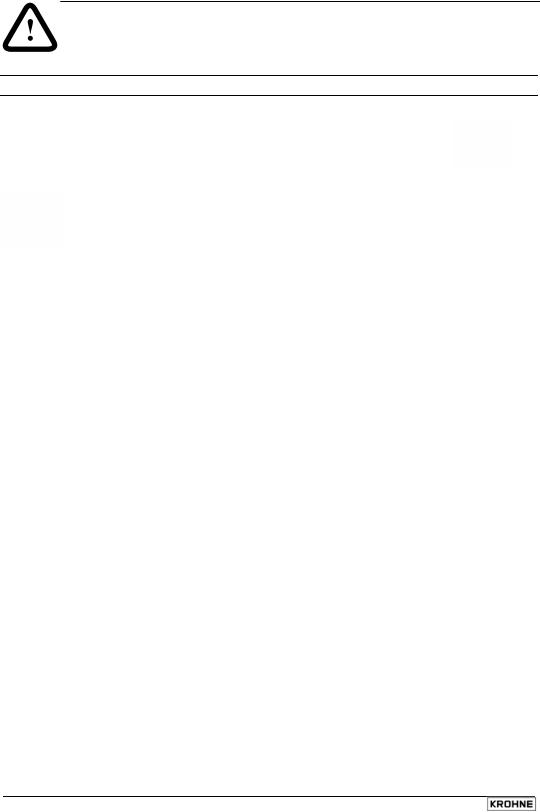
Special certificates (Optional: supplied on customer demand only)
•Test certificate to EN 10204: pressure test, dye penetration test, radiographic test, leak-tightness test, ultrasonic test, helium leak test, surface cleanness and material
Standards / Approvals
In compliance with European Directive 94/9/EC (ATEX 100a), the bypass level indicators described in these instructions conform to European Standards EN50014, EN 50020, EN50018, EN13463-1 and EN 50284 and are certified for use in hazardous locations by the INERIS certification agency under INERIS 02ATEX0088X when equipped with the appropriate options.
WARNING
The details given in this approval certificate together with its boundary conditions must be observed.
This instrument also conforms to the European Union Pressure Equipment Directive 97/23/EC.
Ex Safety Instructions
ATEX-certified BM 26 A level indicators can be used in explosive atmospheres of all flammable substances in Gas Group IIC (with the exception of cases given in these instructions) and applications requiring Category 1 / 2 G and 1 G equipment. The instrument must be installed and used by suitably qualified personnel.
Ex Equipment Category Definitions
Category 1 / 2 G – instruments
(for applications where the Exd-rated explosion-proof box is used)
The signal converter for current output and limit switch options are located in hazardous areas requiring instruments qualified as being category 2. The process connection and tank wall form an interface between zones for category 1 and 2 equipment. The indicator measuring elements (float and measuring tube) are qualified as being category 1. The G rating means that the instrument is qualified for gas environments.
Category 1 G - instruments
The signal converter for current output, limit switch options and measuring components are located in hazardous areas requiring instruments qualified as being category 1.
6 |
Installation and Operating Instructions BM 26 A |
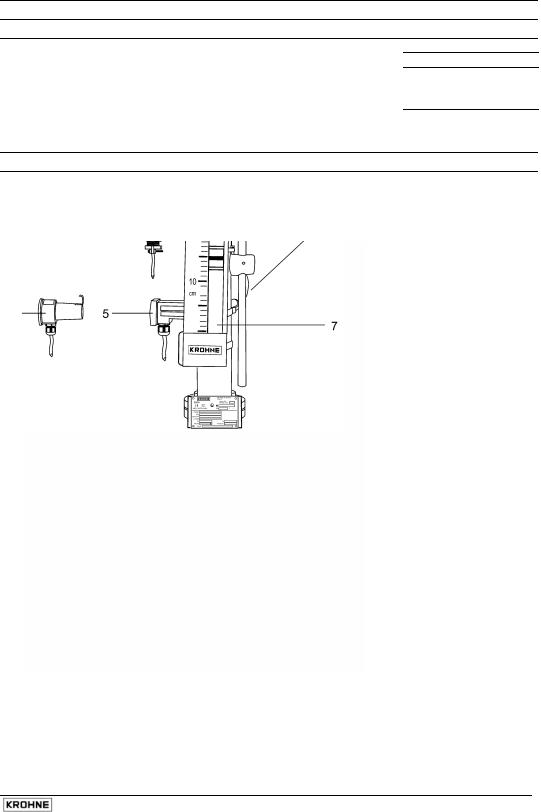
Official approvals and certificates
Application |
Approved by |
Instrument version |
Certification mark |
ATEX certification |
INERIS |
BM 26 A |
Certificate no. |
|
|
|
INERIS 02ATEX0088X* |
|
|
|
|
*This EC-type Examination Certificate is available on KROHNE’s download centre webpage on http://www.krohne.com.
Principal gauge components
1 Level transducer (cable entry fitting not supplied)
2 Process
connections
3 Measuring tube (bypass chamber) containing float loaded with magnets
4 MS 15 /EXD limit switch (cable entry fitting not supplied)
5 MS 15 /STD or /EXI limit switch
6 MS 20 /STD or /EXI limit switch (shown separate from assembly, may replace or be used with items 4 and 5)
7 Scale clamped adjacent to measuring tube integrating a Pyrex tube with float-following indicator bar.
Installation and Operating Instructions BM 26 A |
7 |
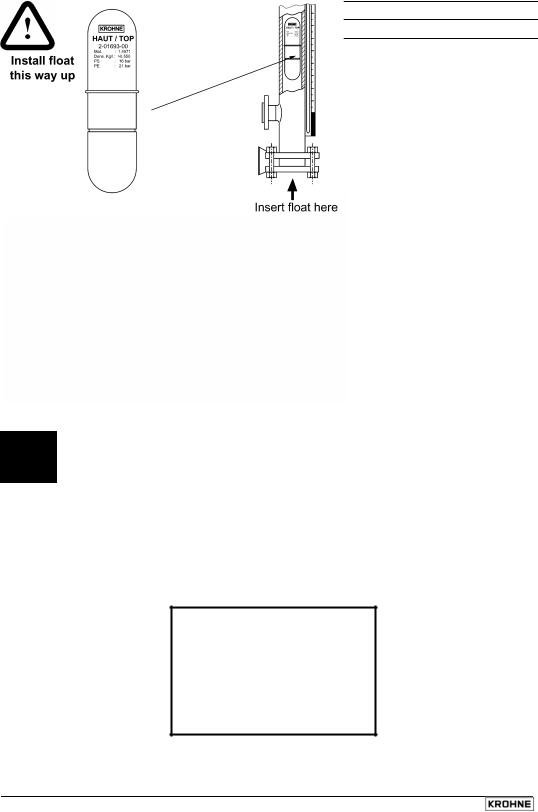
1 Installation
1.1Packing and storage
Floats packed separately
1To install, remove the bottom flange and insert the float – the right way up – into the guide chamber.
2Align gaskets.
3Tighten nuts using the correct torque with regards to the strength of bolts specified for the vessel pressure rating, connecting flange and material.
CAUTION
Make sure that the guide tube is free of foreign bodies (dirt, loose objects, etc.).
Floats held in position during transit by a plastic locking clip
This should be removed from the guide tube before installation through the bottom connection flange. Follow the procedure below:
Step 1 Check measuring tube for a red sticker next to the bottom process connection.
ATTENTION!
Retirer la tige de sécurité maintenant le flotteur
ATTENTION !
Take away transport safety device for float
ACHTUNG !
Transportsicherung für Schwimmer entfernen
8 |
Installation and Operating Instructions BM 26 A |
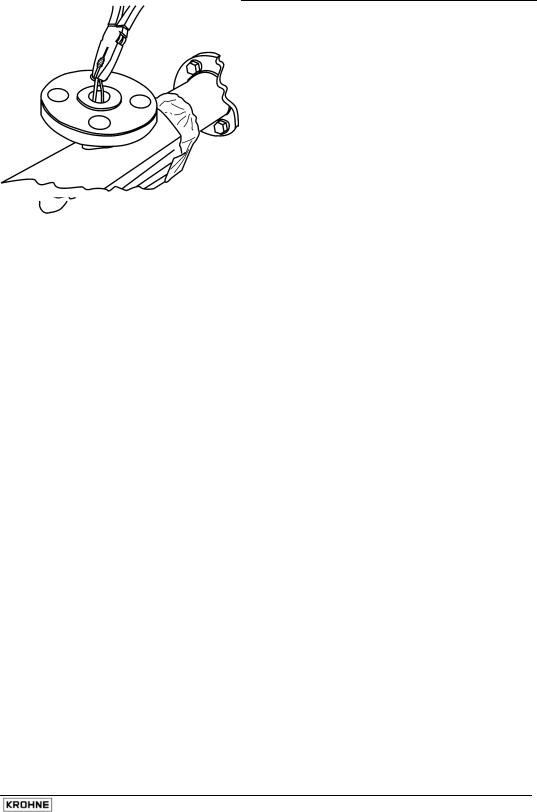
Step 2 |
Undo adhesive tape around |
|
Step 3 Remove process connection plastic |
|
|
bottom process connection |
|
protective cover |
|
|
|
|
|
|
|
|
|
|
|
|
|
|
|
|
Step 4 |
Locate clip |
Step 5 Remove clip with a pair of pliers |
|
|
|
|
|
|
|
|
|
|
|
|
|
|
|
|
|
Installation and Operating Instructions BM 26 A |
9 |
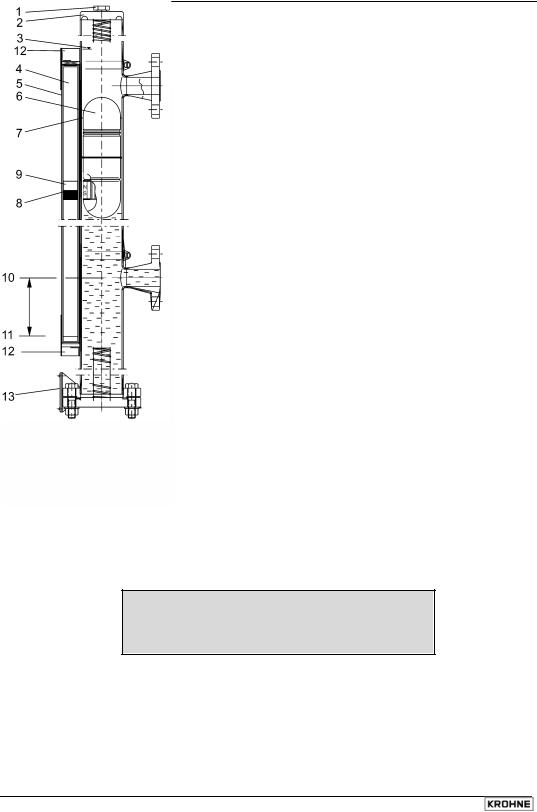
1.2BM 26 A construction details
The diagram below shows a standard BM 26 A/C/RR without level transducer and switch options
1 Vent plug
2 Measuring tube
3 Red triangle reference mark giving factory-calculated zero position of measuring scale
4 Glass tube for indicator
5 Scale
6 Float (magnets mounted in lower half)
7 Liquid level
8 Mid-point of indicator
9 Indicator (standard follower bar)**
10 Zero point of measurement (centreline of lower connecting flange)
11 Scale zero
12 Stop (red KROHNE plate)
13 Instrument nameplate
* optional flap indicator available (see section 8)
Details:
Item 12 – The red KROHNE plate at the bottom of the scale (item 5) has a label listing the product and the operating conditions. For example :
Working pressure : 6 bar g
Working temperature : 25 C
Density : 0.778 s g.
Fluid : cyclohexane
10 |
Installation and Operating Instructions BM 26 A |
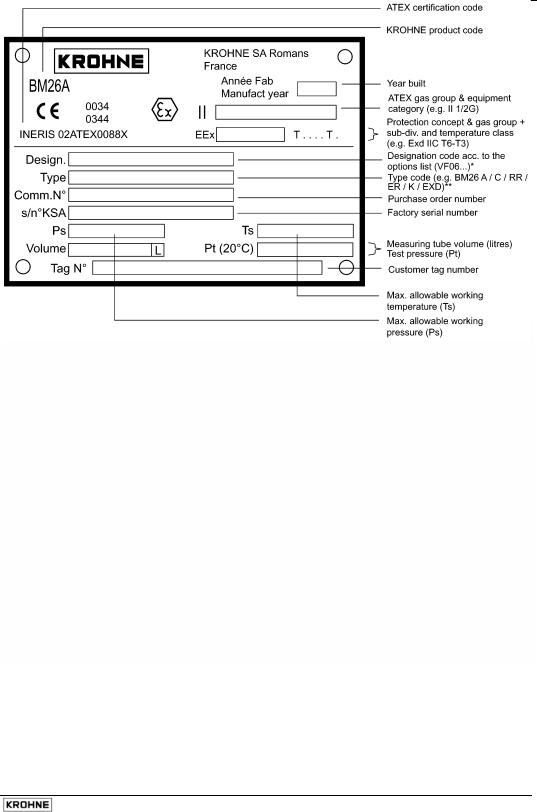
Item 13A – BM 26 A Standard nameplate
Item 13B – BM 26 A ATEX nameplate
*See BM 26 A Data Sheet for a list of standard options and designation codes
**Type code is defined as:
Product code/Process connections/Material code/Design/Level transducer/Contact/Approval
Installation and Operating Instructions BM 26 A |
11 |

Type code
Type code element |
Code |
Code definition |
|
Product code |
BM 26 A |
Bypass Level Indicator (A model) |
|
Process connections |
C |
Two |
lateral connections |
|
D |
Two |
axial connections |
|
E |
One top lateral entry and one bottom axial exit |
|
|
F |
One bottom lateral entry and one top axial exit |
|
Construction material code |
RR |
Stainless steel |
|
Design |
No info |
Standard design |
|
|
B |
Heater |
|
|
AG |
Anti-freeze version -40°C / -40°F |
|
|
IC/TR |
With low temperature insulation |
|
|
IC/HR |
With high temperature insulation |
|
Level transducer |
No info |
Without level transducer |
|
|
ER |
With level transducer |
|
Contact |
No info |
Without limit switches |
|
|
K |
With limit switches |
|
Approval |
No info |
Standard, no approval |
|
|
EXI |
For EEx – intrinsically safe applications |
|
|
EXD |
For EEx – flameproof applications |
|
1.3Mechanical installation requirements
Ensure that the requirements given below have been followed:
•The effective pressure of the installation (the maximum permitted by the pressure limiting valve)
must never be greater than the maximum permitted pressure, Ps, marked on the instrument nameplate. The test pressure, Pt, is given on the order documents and BM 26 A nameplate.
•The user must be sure that materials in contact (guide tube, float, gaskets, etc) with the fluid used are compatible with the fluid and conform to ageing characteristics of the fluid used and the measurement environment. These have either been recommended in the instructions or form the subject of a particular specification in the contract.
•The external pressure (Pext) must be equal to atmospheric pressure(Patmos).
1 Tank
2 Liquid product
3 BM 26A level-liquid indicator (measuring tube):
Vertical installation only!
12 |
Installation and Operating Instructions BM 26 A |
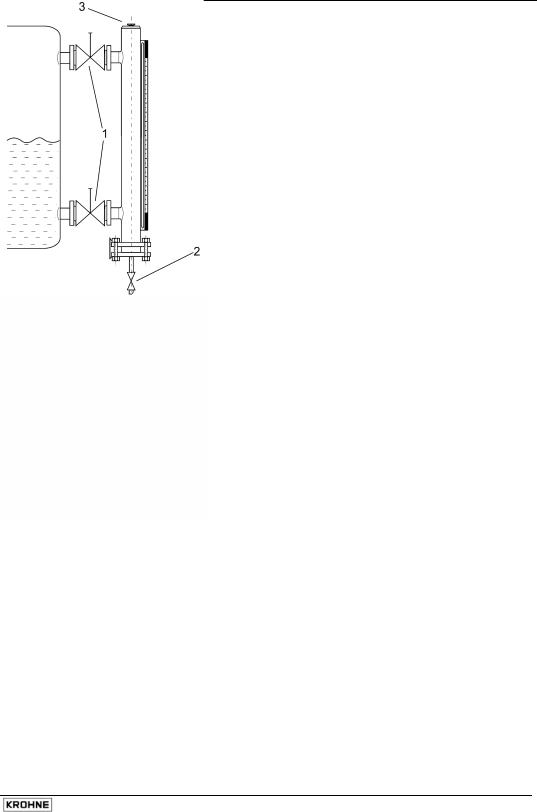
1.4Mounting on the tank
•The BM 26 A bypass level indicator must be installed vertically on the tank
•When installing the BM 26 A bypass level indicator with or without the electrical level transducer system, make sure that any magnetic fields generated by other equipment will not affect measurements.
•Select bolts and gaskets (supplied by customer) that correspond to the pressure rating of the connecting flange and the operating pressure.
•The process connections (flanges) must fit perfectly, i.e. they must be centred, parallel and bolted in a professional way, in order to avoid unnecessary mechanical stress on the installation.
•The tank must be free of contaminants. It is recommended to install shut-off elements, e.g. cocks, valves, etc., between the tank and bypass level indicator to allow the bypass level indicator to be cleaned independently of the tank. The drain plug in the bottom flange must also be replaced by a drainage cock with discharge line.
1Shut-off valve (top and bottom)
2Drainage valve with discharge tube.
3Vent plug
Installation and Operating Instructions BM 26 A |
13 |
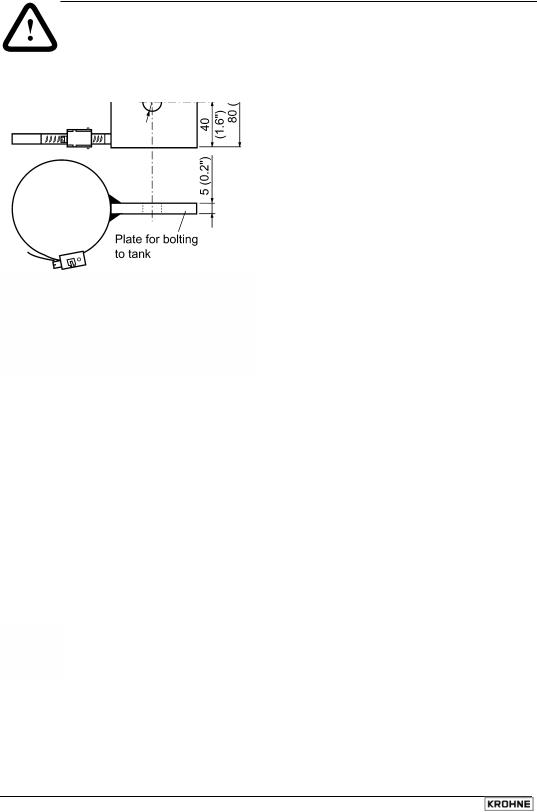
•Additional anchoring points between the BM 26 A and the tank are recommended for very high installations (above 6 metres length for stainless steel). The standard anchor is a set of collars welded to a plate. This is available on demand from KROHNE. See figure below for side and plan view and dimensions in millimetres (inches).
1.5Start-up procedure
|
|
|
WARNING |
|
|
|
Take the necessary safety precautions when working with |
|
|
|
pressurized tanks. |
|
|
|
|
Step |
|
Action |
|
1 |
|
Close drainage plugs and/or drainage cock . |
|
2 |
|
Open shutoff elements at lower and upper connecting flange. |
|
3 |
|
Adjust the position of the local measuring scale so that scale |
|
|
|
|
level corresponds exactly to true level, see section 1.6. |
WARNING
•The user must take the necessary steps to protect the installed instrument from shock waves (water hammer). A pressure limiting valve must equally protect the installation.
•The instrument must regularly undergo servicing to conform to the rules and regulations applicable to the site that it is installed on.
•High Temperature versions - precautions must be taken to avoid burns to operators.
14 |
Installation and Operating Instructions BM 26 A |
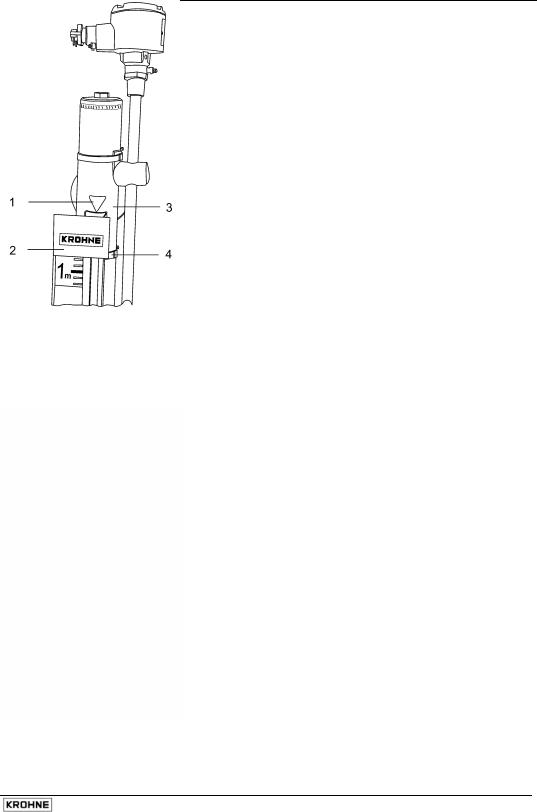
1.6True level indication
1.6.1 Level measurement using the local indicator and scale
The float is equipped with a ring system of permanent magnets for transmission of liquid level to the indicator. The indicator is linked magnetically to the magnet system in the float.
For design reasons, the minimum level in the measuring tube is given by the lower lateral flange connection axis i.e. liquid level zero is the centreline of the lower connecting flange. As can be seen in the diagram of the float and indicator in section 1.2, the bar follows the float below the liquid level.
There is a difference between true liquid level and the indicator position because:
•the float is immersed to a certain depth depending on the product density and float type,
•the float magnets are positioned below the float centreline in order for the float to have good stability.
The scale is delivered correctly set up for measuring the product specified in the order. The red reference mark at the top of the measuring tube (item 1 in the diagram below) shows where the top of the scale must be clamped for the indicator to give an accurate reading of liquid level. No further adjustment is necessary when the gauge is commissioned.
Note
If there is a large change in product density, a product other than the one specified in the order is measured or a different float is installed, the scale on the BM 26 A may require adjusting to give an accurate reading. Contact KROHNE for assistance (see also section 1.6.4 to correct the scale’s position).
1Reference mark : the top of the upper red KROHNE plate must touch the bottom point of the triangle
2Scale
3Measuring tube (containing float)
4Top clamping collar ( scale-measuring tube)
Installation and Operating Instructions BM 26 A |
15 |
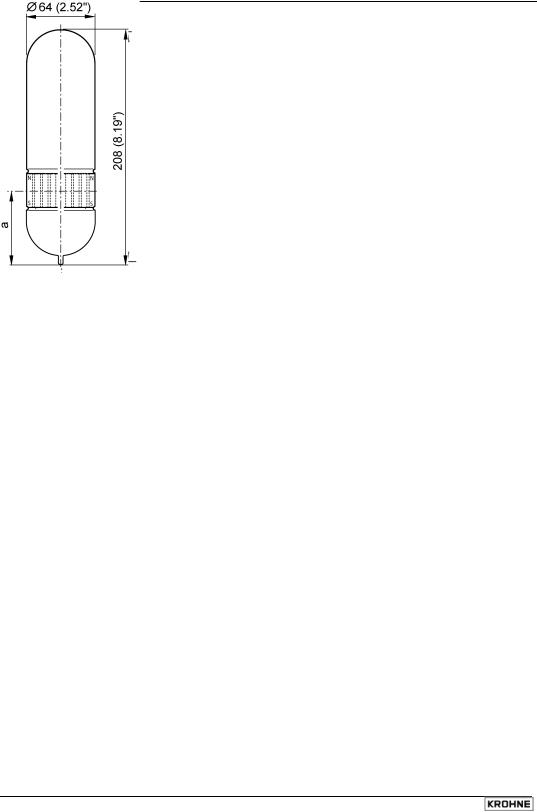
1.6.2 Floats
Four float types are used for liquid level measurement.
•Floats 1 and 2 are made of either 316L or 316Ti (as ordered).
•Floats 3 and 4 are made of titanium
The float number identifies the wall thickness of the float and the material used.
The dimension “a” in the diagrams below gives the distance from the base of the float to the centre line of the integrated magnet system. This should be used in calculations for adjustments to the measuring scale caused by differences between true liquid-level zero and indicated scale zero (see section 1.6.4).
316L or 316Ti floats-No.1 and 2 |
Titanium floats-No. 3 and 4 |
||
|
|
|
|
|
|
|
|
|
|
|
|
where a = 47 mm or 1.85“ and :
Float No.1 wall thickness = 1mm or 0.04” Float No.2 wall thickness = 0.5mm or 0.02”
Dimensions in mm (inches)
Note
where a = 48 mm or 1.89“ |
|
and : |
|
Float No.3 wall thickness = 0.6mm |
or 0.024” |
Float No.4 wall thickness = 1mm |
or 0.04” |
Minor variants of the above exist for particular applications: very low density products, interface measurement applications and so on. Contact KROHNE for further information.
16 |
Installation and Operating Instructions BM 26 A |

Density and operating temperature limits
Float |
Density and operating temperature limits |
|
|
|
||
type |
|
|
|
|
|
|
No. |
Min. density of product |
Product temperature |
|
|
||
|
|
|
Min. |
|
Max. |
|
|
kg/l |
lbs/ |
°C |
°F |
°C |
°F |
|
|
ft3 |
|
|
|
|
BM 26 A / |
Standard versions without approvals |
|
|
|
||
1 |
0.82 |
51.19 |
– 200 |
– 325 |
300 |
570 |
2 |
0.55 |
34.34 |
– 200 |
– 325 |
300 |
570 |
3 |
0.50 |
31.21 |
– 200 |
– 325 |
300 |
570 |
4 |
0.60 |
37.46 |
– 200 |
– 325 |
300 |
570 |
Instruments |
or approved |
for use in Ex |
hazardous zones |
|
|
|
BM 26 A / ATEX (local indicator with electrical equipment) |
|
|
||||
1 |
0.82 |
51.19 |
– 40 |
– 40 |
70 … 195* |
160…380* |
2 |
0.55 |
34.34 |
– 40 |
– 40 |
70 … 195* |
160…380* |
3 |
0.50 |
31.21 |
– 40 |
– 40 |
70 … 195* |
160…380* |
4 |
0.60 |
37.46 |
– 40 |
– 40 |
70 … 195* |
160…380* |
* The product temperature depends on the BM 26 A ATEX temperature class (T3 … T6). See section 7.1 for further information.
Operating pressure limits
Float type |
Operating pressure limits of the float |
|
|
|
||||
BM 26 A |
|
|
|
|
|
|
|
|
No. |
Max. allowable operating pressure |
|
|
|
|
|||
|
At 20°C / 70°F |
At 100°C / 210°F |
At 200°C / 390°F |
At 300°C / 570°F |
||||
|
bar |
psig |
bar |
psig |
bar |
psig |
bar |
psig |
Standard versions |
without |
approvals |
|
|
|
|
|
|
1 |
55 |
800 |
41 |
600 |
37 |
535 |
32 |
465 |
2 |
23 |
335 |
12 |
175 |
10 |
145 |
9 |
130 |
3 |
23 |
335 |
13 |
190 |
10 |
145 |
8 |
115 |
4 |
55 |
800 |
31 |
450 |
24 |
350 |
19 |
275 |
Instruments approved for use in Zone 0 |
|
|
|
|
|
|||
BM 26 A/ATEX (local indicator with electrical equipment) |
|
|
|
|||||
1 |
55 |
800 |
41 |
600 |
– |
– |
– |
– |
2 |
23 |
335 |
12 |
175 |
– |
– |
– |
– |
3 |
23 |
335 |
13 |
190 |
– |
– |
– |
– |
4 |
55 |
800 |
31 |
450 |
– |
– |
– |
– |
Important note
Float test pressure is tested according to pressure equipment directive 97/23/EC and official approvals.
Installation and Operating Instructions BM 26 A |
17 |

1.6.3 Changing the process conditions
If the user wishes to use the BM 26 A to measure another product, then the following points should be noted:
•Contact KROHNE for advice and information on equipment / product compatibility especially where use in hazardous areas is concerned.
•Ensure that Pressure Equipment Directive 97/23/EC is observed, if relevant.
•The depth of immersion “c” (see section 1.6.4) of the float increases as product density decreases. This depth is also dependent on the float model (No. 1, 2, 3 or 4) and material used (316L, 316Ti or titanium). The new depth of immersion “c” is shown on the two line graphs below. Further information is available from KROHNE on request to accurately calibrate your instrument. When contacting KROHNE remember to:
−quote KROHNE references (order / fabrication no.) for the BM 26 A in question
−identify the new product and give its density at the new operating conditions.
−give information about the old application. Floats may have been especially adapted for specific applications; for example: densityadjusted (pressurized) or floats for low density applications and floats with ballast for interface measurement.
•The top of the float must be no more than 35mm or 1.38” above the product surface to ensure reliable floatability and accurate measurement.
Graph 1: Float immersion depth against product density
Line 1 : Float no. 1 made of 316Ti (1.4571) or 316L (1.4404), wall thickness 1mm or 0.04” Line 2 : Float no. 2 made of 316Ti (1.4571) or 316L (1.4404), wall thickness 0.6 mm or 0.02”
Where c is immersion depth and ρ is product density
18 |
Installation and Operating Instructions BM 26 A |
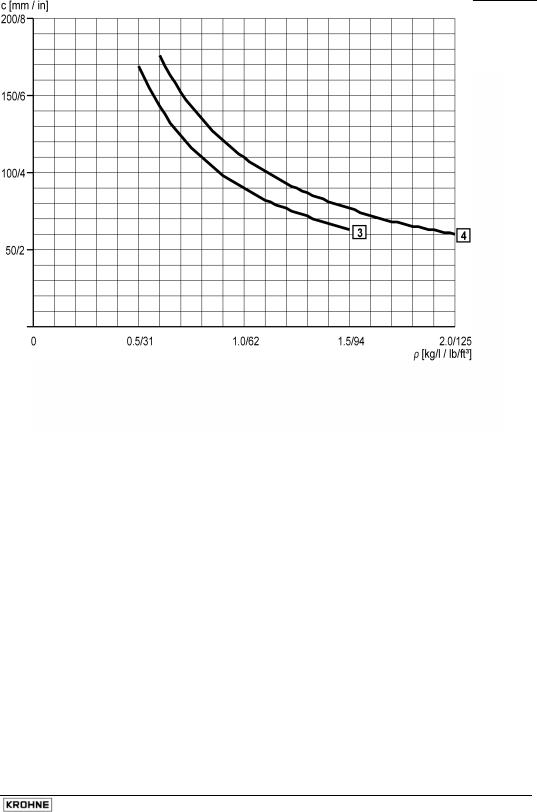
Graph 2: Float immersion depth against product density
Line 3 : Float no. 3 made of titanium, wall thickness 0.6 mm or 0.024”
Line 4 : Float no. 4 made of titanium, wall thickness 1 mm or 0.04”
Where c is immersion depth and ρ is product density
Installation and Operating Instructions BM 26 A |
19 |
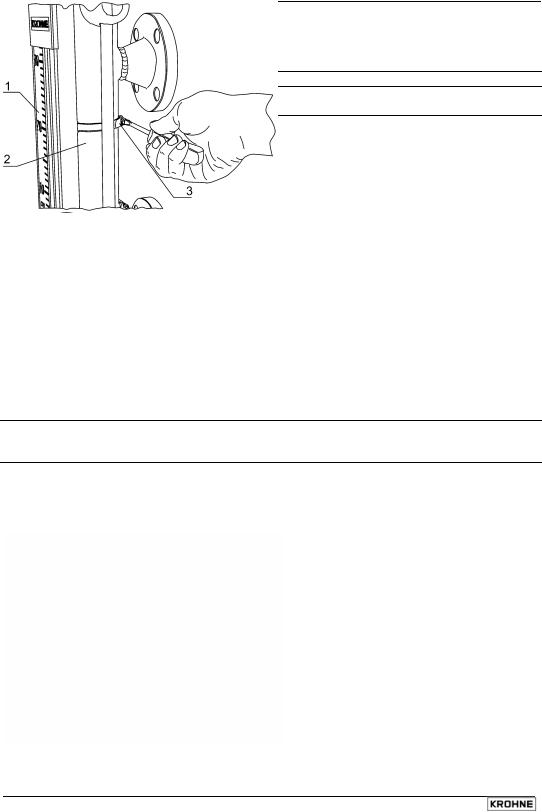
1.6.4 Correcting the scale position to accurately read true liquid level
The scale* can be corrected by the customer using the following procedure:
Step Action
1Find the float immersion depth “c” (supplied by KROHNE, refer also to section 1.6.3).
2Subtract the dimension “a”, float base to magnet centreline (given on the float dimensioned drawing in Section 1.6.2), from “c” to get the dimension “b”, scale correction factor.
Item |
Description |
|
|
|
|
|
|
b = |
c – a (difference between liquid level |
|
|
|
and indicator position due to product |
|
|
|
density) |
|
|
c = |
float immersion depth (a function of |
|
|
|
product density), see section 1.6.3. |
|
|
a = |
distance from centerline of magnet |
|
|
|
system to the float base, see |
|
|
|
dimensioned float drawings in |
|
|
|
section 1.6.2. |
|
|
1 = |
Float |
|
|
|
|
|
|
2 = |
Follower magnet of indicator (or limit |
|
|
|
switch) |
|
|
3 = |
Position of magnets mounted in the |
|
|
|
float |
|
|
|
|
|
|
3Loosen the two clamp collars holding the measuring scale onto the measuring tube using a screwdriver or 8 mm wrench.
4Bring the zero point (top of the lower red KROHNE plate) on the scale into line with the centreline of the bottom lateral process connection.
4a Undo top collar
1 Measuring scale
2 Measuring tube
3 Top measuring scale collar
*This information also applies to the initial setting up of limit switches – however, the fitter should also remember to take into account the limit switches offset trigger point (see section 3.6).
20 |
Installation and Operating Instructions BM 26 A |
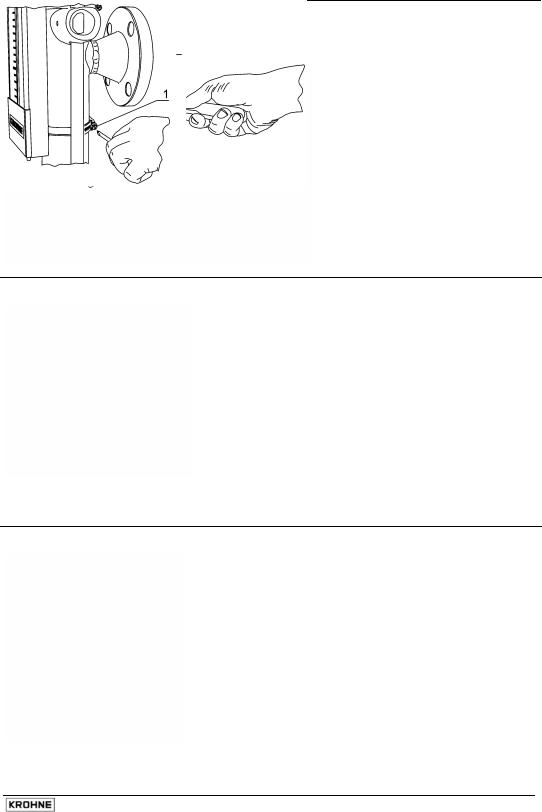
4b Undo bottom collar
4c Zero the scale (default)
1 Measuring scale
2 Bottom of scale (item 1) indicated by top of red KROHNE plate. Default position is on the same level as item 3.
3 Centreline of bottom lateral process connection.
4 Bottom measuring scale clamp
5Move the measuring scale down the measuring tube to set to by “b” mm.
1Centreline of bottom lateral process connection.
2Bottom of scale (item 1) indicated by top of red KROHNE plate.
3Position of float (dashed lines) when measuring tube filled up to the centre line of bottom lateral process connection.
B Move scale down measuring tube by “b” mm. The bottom of the scale will then be at the same level as the magnets in the float
6 Retighten the two collars holding the measuring scale onto the measuring tube.
1 Measuring scale collar screw
Installation and Operating Instructions BM 26 A |
21 |

1.6.5 Functional check of local level display (bar indicator only)
Step |
Action |
Comments |
1 |
Break the magnetic bond between the |
The indicator bar (9*) will drop down and |
|
float and the indicator bar using a bar |
disappear behind the red cover (12*) on |
|
magnet. |
the front scale. |
2 |
Retrieve the indicator the bottom of the |
The indicator will again magnetically bond |
|
tube with a bar magnet. Lift up the tube. |
with the float at the correct indicated value. |
3 |
End of the procedure. |
If the indicator bar fails to bond |
|
|
magnetically, please contact KROHNE for |
|
|
assistance. |
*See diagram in section 1.2.
22 |
Installation and Operating Instructions BM 26 A |
